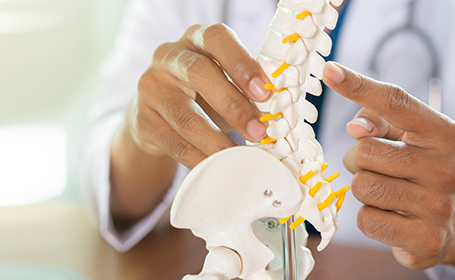
Spinal Surgery Q&A
When is spinal surgery necessary and what does it entail? Three of our spinal consultants answer common questions on spinal surgery, including the risks, recovery and alternatives
Meet the consultants
- Mr Neil Orpen is a consultant spinal surgeon based at The Ridgeway Hospital
- Mr Matthias Radatz is a consultant neurosurgeon based at The Thornbury Hospital
What are the main types of spinal surgery?

Mr Neil Orpen: Some of the most common types of spinal surgery are:
-
Pain injections
-
Disc surgery
-
Decompression surgery
-
Disc replacement surgery
-
Fusion surgery
-
Deformity correction surgery
-
Surgery for fractures and cancer
Mr Matthias Radatz: I deal routinely with all aspects of spinal and complex spinal surgery including surgery to the cervical, thoracic and lumbar spine with and without instrumentation as well as for spinal column and cord tumours and vascular abnormalities.
Spinal surgery for degenerative problem like stenosis and discogenic root or cord compression are the most common and represent the daily routine in my practice.
Surgical intervention is the most invasive treatment option and needs to be very carefully considered.

When is spinal surgery needed?
Mr Neil Orpen: Surgery for the spine is used in a number of situations but usually as a way of either taking pressure off spinal nerves or stabilising the spine in situations of deformity (loss of normal spinal shape). Fortunately it is often a choice once all other treatment modalities have been exhausted but still it can be a very effective and permanent solution to spinal related pain.
Mr Matthias Radatz: Surgical intervention is the most invasive treatment option and needs to be very carefully considered. Depending on the circumstances of presentation, with or without an increasing neurological deficit, surgery might be avoidable.
Surgery carries risks and there is never a guarantee of a favourable outcome. It's really important to pay attention to detail and to tailor treatment options to each patient's individual underlying problem and their needs and expectations. Less invasive treatment modalities should have been tried and exhausted before entering spinal surgery, which should be seen as the last resort in the absence of clear urgent or emergency indications.
Are there alternatives to spinal surgery?
Mr Neil Orpen: Depending on the problem, other treatment forms may be appropriate. Such as:
-
Physiotherapy
-
Osteopathy
-
Chiropractic treatment
-
Spinal injections such as caudal epidural, facet joint injections and nerve root block
Consideration must always be given to whether these are likely to be a long term solution. Steroid based spinal injections, particularly for nerve pain, can be very effective in bringing a pain episode to a more rapid end. In situations of back and neck pain, it is usually more common for physical and manipulative therapies to be the first choice.
Mr Matthias Radatz: Yes there are many alternatives, which should be trialled in the first instance.
These can include; medicinal treatment, physiotherapy, osteopathy, chiropractice and alternative treatments of TENS, acupuncture and reflexology. The next line of management would be to engage into a pain management program with possible injections to help in particular with pain.

What happens during spinal surgery?
Mr Neil Orpen: Spinal operations are quite varied and are dependent on the aims of the particular operation. For example:
-
A simple discectomy involves taking a small piece of disc out from the spine
-
Spinal decompression involves cutting a piece of bone away (de-roofing the spine) to improve the space for nerves
-
Spinal fusion involves insertion of metal work. This can include surgery from the front of the spine – usually to put in cages – and from the back to put in screws and rods
-
Spinal scoliosis correction of young people can involve surgery from both the front and the back – or only from the front or the back depending on the size of the curve
-
Spinal scoliosis correction and reconstruction in adults is very complex surgery that may or may not include all of the above
Although injections are simple procedures performed under local anaesthetic in an outpatient setting, more typically surgery is performed under general anaesthetic as an inpatient.
Many procedures can now be performed utilising minimally invasive surgery (keyhole techniques) and patients should always enquire whether this is an option available. Surgery typically is aimed at taking pressure off nerves or stabilising bones in the spine, in the form of fusion.
Mr Matthias Radatz: The procedure chosen entirely depends on the underlying abnormality which needs to be addressed. Nearly all procedures are carried out with the use of an operating microscope, some with spinal cord monitoring and image intensifier or image guidance.
What happens during surgery depends on the procedure. The most common problem is a disc prolapse which will typically removed with specialist instrumentation. Excellent microsurgical technique , meticulous dissection and tissue handling are very important factors in deciding surgical outcome.
Risks are identifiable and so surgical techniques have been developed to improve the risk profile.

What are the risks of spinal surgery?
Mr Neil Orpen: The risks depend on the type of spinal surgery. These may include:
-
Infection. There is always a risk of infection when having surgery. This can be of the wound, more deeply or of the inserted metal work
-
Developing blood clots in the legs or lungs which is why mobilisation as soon as possible after surgery is important
-
Damage to nerves. All surgery of the spine has a risk of damaging nerves. This can be minor or major
As surgery is performed on nerves, these are at risk of being injured. Utilising a surgical microscope improves the safety of this and surgeons experience is also a factor. Risks are identifiable and so surgical techniques have been developed to improve the risk profile. As bones are at risk of not fusing in the presence of nicotine, patients will routinely be asked to stop smoking prior to considering a fusion procedure.
Mr Matthias Radatz: The risks involved in spinal surgery depend on many factors. At a rule of thumb:
-
The more invasive, the more risky
-
The more implants used, the more risky
The general advice is to keep it simple and safe and rely on proven techniques and evidence based procedures. Careful selection and procedure planning can reduce risks significantly.
Risks may include; infection, root damage, cord damage, cerebro-spinal fluid leak, increased neurological deficit, incontinence, scarring, chronic pain, recurrent problems, instability and the need for further surgery to achieve fusion.
The use of implants adds another level of risk as those can fatigue, fracture, migrate, dislodge and can potentially be malplaced.
Recovery from spinal surgery requires time. The time required depends on the extent of the procedure and the underlying pathology and varies greatly.
What is involved in the recovery from spinal surgery?
Mr Neil Orpen: Recovery plans depend entirely on what procedure has been performed and the surgeon in conjunction with physiotherapy will direct a plan. Following a simple discectomy and decompression surgery, patients will often return to work within three to four weeks. Following minimally invasive fusions, approximately six weeks. Usually following cervical disc replacement surgery return to driving and work is within two weeks.
Mr Matthias Radatz: Recovery from spinal surgery requires time. The time required depends on the extent of the procedure and the underlying pathology and varies greatly. The guidance and supervision from physiotherapists and occupational therapists is very important.
Recovery from disc surgery typically requires a rehabilitation for four to six weeks. Driving will be affected in the first few weeks after intervention. Most important is the gradual increase of activity over the rehabilitation period and patience to allow for a gradual re-conditioning.
Will I be able to play sports?
Mr Neil Orpen: Sport is naturally possible following surgery, but the return to full activities will need to be planned.
Mr Matthias Radatz: Again this needs to be individually evaluated. Spinal surgery is in general carried out to restore the physical abilities and in this context typically allows individuals to re-integrate into there sport of choice. It is important to discuss these issues with your surgeon as certain sports will put individuals at a higher risk of suffering recurrent problems. Your surgeon will typically advise on dos and don'ts and take your physical abilities into account as well as the underlying pathology.
Tags
How do I book an appointment?
If you're concerned about symptoms you're experiencing or require further information on this subject, talk to a GP or see an expert consultant at your local Circle Hospital.